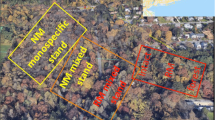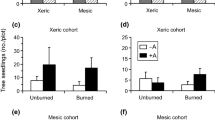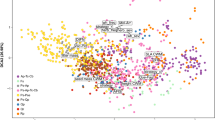Abstract
Invasion of alien plant species can have irreversible effects on ecosystems. Although alien plants often distribute in disturbed area, understanding of the initial invasion process soon after disturbance is poor. We compared forest floor vegetation between thinning treatment plots and intact control plots in a red pine (Pinus densiflora) forest in central Japan to test whether the thinning treatment (i.e. disturbance) induced invasion of alien plants. We also examined how invasion of aliens is influenced by the environment, plant traits, and buried seeds in the soil. In control plots, few alien plants emerged at the herbaceous layer and only a few buried seeds of alien plants were found. In treatment plots, on the other hand, many alien plants were observed both at the herbaceous layer and in the soil seed bank. Treatment plots had a larger percentage of canopy openness than control plots. In treatment plots, the cover of alien plants was negatively correlated with the distance from the nearest primary road. Alien plants had taller maximum plant height, larger leaves, and greater leaf nitrogen concentration than native species in treatment plots. This indicates that alien plants were superior to native plants in growth, competition, and carbon assimilation abilities. Alien plants tended to have seeds with long dispersal abilities, such as anemochory and zoochory, and short life histories, such as annual and biennial histories. These findings suggest that thinning promoted invasion of alien plants and that alien plants had the potential for further invasion by rapid dispersion, establishment, and growth.







Similar content being viewed by others
References
Aerts R, Ewald M, Nicolas M, Piat J, Skowronek S, Lenoir J, Hattab T, GarzónLópez CX, Feilhauer H, Schmidtlein S, Rocchini D, Decocq G, Somers B, Van De Kerchove R, Denef K, Honnay O (2017) Invasion by the alien tree Prunus serotina alters ecosystem functions in a temperate deciduous forest. Front Plant Sci 8:179. https://doi.org/10.3389/fpls.2017.00179
Bartoń K (2019) Multi-model inference. R package version 1.43.15
Baruch Z, Fernandez DS (1993) Water relations of native and introduced C4 grasses in a neotropical savanna. Oecologia 96:179–185. https://doi.org/10.1007/BF00317730
Baruch Z, Goldstein G (1999) Leaf construction cost, nutrient concentration, and net CO2 assimilation of native and invasive species in Hawaii. Oecologia 1221:183–192. https://doi.org/10.1007/s004420050920
Belote RT, Jones RH, Hood SM, Wender BW (2008) Diversity-invasibility across an experimental disturbance gradient in Appalachian forests. Ecology 89:183–192. https://doi.org/10.1890/07-0270.1
Bigelow SW, Canham CD (2002) Community organization of tree species along soil gradients in a north-eastern USA forest. J Ecol 90:188–200. https://doi.org/10.1046/j.0022-0477.2001.00
Canessa R, Saldaña A, Ríos RS, Gianoli E (2018) Functional trait variation predicts distribution of alien plant species across the light gradient in a temperate rainforest. Perspect Plant Ecol Evol Syst 32:49–55. https://doi.org/10.1016/j.ppees.2018.04.002
Catford JA, Daehler CC, Murphy HT, Sheppard AW, Hardesty BD, Westcott DA, Rejmánek M, Bellingham PJ, Pergl J, Horvitz CC, Hulme PE (2012) The intermediate disturbance hypothesis and plant invasions: Implications for species richness and management. Perspect Plant Ecol Evol Syst 14:231–241. https://doi.org/10.1016/j.ppees.2011.12.002
Charbonneau NC, Fahrig L (2004) Influence of canopy cover and amount of open habitat in the surrounding landscape on proportion of alien plant species in forest sites. Ecoscience 11:278–281. https://doi.org/10.1080/11956860.2004.11682833
Closset-Kopp D, Chabrerie O, Valentin B, Delachapelle H, Decocq G (2007) When Oskar meets alice: does a lack of trade-off in r/K-strategies makes Prunus serotina. A successful invader of European forests? For Ecol Manag 247:120–130. https://doi.org/10.1016/j.foreco.2007.04.023
Collette LK, Pither J (2015) Modeling the potential North American distribution of Russian olive, an invader of riparian ecosystems. Plant Ecol 216:1371–1383. https://doi.org/10.1007/s11258-015-0514-4
D’Antonio CM, Yelenik S, Mack MC (2017) Ecosystem versus community recovery 25 years after grass invasions and fire in a subtropical woodland. J Ecol 105:1462–1474. https://doi.org/10.1111/1365-2745.12855
Dainese M, Bragazza L (2012) Plant traits across different habitats of the Italian Alps: a comparative analysis between native and alien species. Alp Bot 122:11–21. https://doi.org/10.1007/s00035-012-0101-4
Dale VH, Adams WM (2003) Plant reestablishment 15 years after the debris avalanche at mount St. Helens, Washington. Sci Total Environ 313:101–113. https://doi.org/10.1016/S0048-9697(03)00332-2
Davis MA, Grime JP, Thompson K (2000) Fluctuating resources in plant communities: a general theory of invasibility. J Ecol 88:528–534. https://doi.org/10.1046/j.1365-2745.2000.00473.x
Davis MA, Pelsor M (2001) Experimental support for a resource-based mechanistic model of invasibility. Ecol Lett 4:421–428. https://doi.org/10.1046/j.1461-0248.2001.00246.x
Döbert TF, Webber BL, Sugau JB, Dickinson KJM, Didham RK (2018) Logging, exotic plant invasions, and native plant reassembly in a lowland tropical rain forest. Biotropica 50:254–265. https://doi.org/10.1111/btp.12521
Dyderski MK, Jagodziński AM (2019a) Seedling survival of Prunus serotina Ehrh., Quercus rubra L. and Robinia pseudoacacia L. in temperate forests of Western Poland. For Ecol Manag 450:117498. https://doi.org/10.1016/j.foreco.2019.117498
Dyderski MK, Jagodziński AM (2019b) Functional traits of acquisitive invasive woody species differ from conservative invasive and native species. NeoBiota 41:91–113. https://doi.org/10.3897/neobiota.41.31908
Ender CL, Christian CE, Cushman JH (2017) Native herbivores and environmental heterogeneity as mediators of an exotic grass invasion. Ecol Evol 7:1561–1571. https://doi.org/10.1002/ece3.2727
Faist AM, Stone H, Tripp EA (2015) Impacts of mastication: soil seed bank responses to a forest thinning treatment in three Colorado (USA) conifer forest types. Forests 6:3060–3074. https://doi.org/10.3390/f6093060
Falster DS, Westoby M (2003) Plant height and evolutionary games. Trend Ecol Evol 18:337–343. https://doi.org/10.1016/S0169-5347(03)00061-2
Feng YL, Auge H, Ebeling SK (2007a) Invasive Buddleja davidii allocates more nitrogen to its photosynthetic machinery than five native woody species. Oecologia 153:501–510. https://doi.org/10.1007/s00442-007-0759-2
Feng YL, Wang J, Sang W (2007b) Biomass allocation, morphology and photosynthesis of invasive and noninvasive exotic species grown at four irradiance levels. Acta Oecol 31:40–47. https://doi.org/10.1016/j.actao.2006.03.009
Garnier E, Laurent G, Bellmann A, Debain S, Berthelier P, Ducout B, Roumet C, Navas ML (2001) Consistency of species ranking based on functional leaf traits. New Phytol 152:69–83. https://doi.org/10.1046/j.0028-646x.2001.00239.x
Gioria M, Pyšek P (2017) Early bird catches the worm: germination as a critical step in plant invasion. Biol Invas 19:1050–1088. https://doi.org/10.1007/s10530-016-1349-1
Gross N, Suding NK, Lavorel S (2007) Leaf dry matter content and lateral spread predict response to land use change for six subalpine grassland species. J Veg Sci 18:289–300. https://doi.org/10.1111/j.1654-1103.2007.tb02540.x
Hamada H, Kuramoto N (1994) A study of seed bank in Quercus serrata forest by surveying seedling emergence and its application to forest management. J Jpn Inst Landsc Archit 58:76–82. https://doi.org/10.5632/jila.58.76
Hayashi I (1977) Seed bank population. In: Numata M (Ed.) Succession of plant community and the mechanism of it—the course of plant ecology IV—, Asakura, Tokyo pp 193–203 (in Japanese)
Hothorn T, Hornik K (2019) Exact distributions for rank and permutation tests. R package version 0:8-31
Kawanishi M, Sakio H, Yonebashi T (2007) A comparative study of buried seed assemblages in conifer plantation and secondary broad-leaved forest. Bull Geo-Environ Sci Rissho Univ 9:31–41
Kazakou E, Vile D, Shipley B, Gallet C, Garnier E (2006) Co-variations in litter decomposition, leaf traits and plant growth in species from a Mediterranean oldfield succession. Funct Ecol 20:21–30. https://doi.org/10.1111/j.1365-2435.2006.01080.x
Kelly AB, Small CJ, Dreyer GD (2009) Vegetation classification and invasive species distribution in natural areas of southern New England. J Torrey Bot Soc 136:500–519. https://doi.org/10.3159/09-RA-007.1
Knüsel S, Conedera M, Bugmann H, Wunder J (2019) Low litter cover, high light availability and rock cover favour the establishment of Ailanthus altissima in forests in southern Switzerland. NeoBiota 46:91–116. https://doi.org/10.3897/neobiota.46.35722
Kuenzi AM, Fulé PZ, Sieg CH (2008) Effects of fire severity and pre-fire stand treatment on plant community recovery after a large wildfire. For Ecol Manag 255:855–865. https://doi.org/10.1016/j.foreco.2007.10.001
Lake JC, Leishman MR (2004) Invasion success of exotic plants in natural ecosystems: the role of disturbance, plant attributes and freedom from herbivores. Biol Conserv 117:215–226. https://doi.org/10.1016/S0006-3207(03)00294-5
Leishman MR, Thomson VP (2005) Experimental evidence for the effects of additional water, nutrients and physical disturbance on invasive plants in low fertility Hawkesbury Sandstone soils, Sydney, Australia. J Ecol 93:38–49. https://doi.org/10.1111/j.1365-2745.2004.00938.x
Leishman MR, Haslehurst T, Ares A, Baruch Z (2007) Leaf trait relationships of native and invasive plants: community and global-scale comparisons. New Phytol 176:635–643. https://doi.org/10.1111/j.1469-8137.2007.02189.x
Leishman MR, Thomson VP, Cooke J (2010) Native and exotic invasive plants have fundamentally similar carbon capture strategies. J Ecol 98:28–42. https://doi.org/10.1111/j.1365-2745.2009.01608
Lembrechts JJ, Alexander JM, Cavieres LA, Haider S, Lenoir J, Kueffer C, McDougall K, Naylor BJ, Nunez MA, Pauchard A (2017) Mountain roads shift native and non-native plant species ranges. Ecography 40:353–364. https://doi.org/10.1111/ecog.02200
Martin FM, Dommanget F, Janssen P, Spiegelberger T, Viguier C, Evette A (2019) Could knotweeds invade mountains in their introduced range? An analysis of patches dynamics along an elevational gradient. Alp Bot 129:33–42. https://doi.org/10.1007/s00035-018-0214-5
Moles AT, Gruber MAM, Bonser SP (2008) A new framework for predicting invasive plant species. J Ecol 96:13–17. https://doi.org/10.1111/j.1365-2745.2007.01332.x
Molina-Montenegro MA, Cleland EE, Watts SM, Broitman BR (2012) Can a breakdown in competition-colonization tradeoff help explain the success of exotic species. in the California flora? Oikos 121:389–395. https://doi.org/10.1111/j.1600-0706.2011.18943.x
Nakagoshi N, Nehira K, Nakane K (1983) Vegetation restoration in post-fire red pine forest. Seed bank in the initial stage IV. Bull Hiroshima Univ Grad Sch Integr Arts Sci 8:87–110 (in Japanese)
Otto R, Arteaga M, Delgado J, Arévalo J, Blandino C, Fernández-Palacios J (2014) Road edge effect and elevation patterns of native and alien plants on an oceanic island (Tenerife, Canary Islands). Folia Geobot 49:65–82. https://doi.org/10.1007/s12224-013-9159-z
Paclibar GCB, Tadiosa ER (2019) Ecological niche modeling of invasive alien plant species in a protected landscape. Global J Environ Sci Manage 5:371–382. https://doi.org/10.22034/gjesm.2019.03.09
Pattison Z, Vallejo-Marin M, Willby N (2019) Riverbanks as battlegrounds: why does the abundance of native and invasive plants vary? Ecosystems 22:578–586. https://doi.org/10.1007/s10021-018-0288-3
Pauchard A, Alaback PB (2006) Edge type defines alien plant species invasions along Pinus contorta burned, highway and clearcut forest edges. For Ecol Manag 223:327–335. https://doi.org/10.1016/j.foreco.2005.11.020
Puth LM, Post DM (2005) Studying invasion: have we missed the boat? Ecol Lett 8:715–721. https://doi.org/10.1111/j.1461-0248.2005.00774.x
R Core Team (2017) R: a language and environment for statistical computing. R Foundation for Statistical Computing, Vienna, AT. https://www.R-project.org/. Accessed 15 Nov 2016
Radtke A, Ambraß S, Zerbe S, Tonona G, Fontanac V, Ammer C (2013) Traditional coppice forest management drives the invasion of Ailanthus altissima and Robinia pseudoacacia into deciduous forests. For Ecol Manag 291:308–317. https://doi.org/10.1016/j.foreco.2012.11.022
Razanajatovo M, Maurel N, Dawson W, Essl F, Kreft H, Pergl J, Kühn I, Pyšek P, Weigelt P, Winter M, van Kleunen M (2016) Plants capable of selfing are more likely to become naturalized. Nat Commun 7:13313. https://doi.org/10.1038/ncomms13313
Reichard SH, Hamilton CW (1997) Predicting Invasions of Woody Plants Introduced into North America. Conserv Biol 11:193–203. https://doi.org/10.1046/j.1523-1739.1997.95473.x
Ryser P, Aeschlimann U (1999) Proportional dry-mass content as an underlying trait for the variation in relative growth rate among 22 Eurasian populations of Dactylis glomerata s.l. Funct Ecol 13:473–482. https://doi.org/10.1046/j.1365-2435.1999.00349.x
Šerá B (2010) Road-side herbaceous vegetation: life history groups and habitat preferences. Pol J Ecol 58:69–79
Signorell A (2020) Tools for descriptive statistics. R package version 0.99.32
Soler R, Rumpf SB, Schindler S, Pastur GM, Barrera M, Cellini JM, Flores MP, Essl F, Rabitsch W, Lencinas MV (2019) Twelve-year dynamics of alien and native understorey plants following variable retention harvesting in Nothofagus pumilio forests in Southern Patagonia. For Ecol Manag 449:117447
Song XY, Hogan JA, Brown C, Cao M, Yang J (2017) Snow damage to the canopy facilitates alien weed invasion in a subtropical montane primary forest in southwestern China. For Ecol Manag 391:275–281. https://doi.org/10.1016/j.foreco.2017.02.031
Takahashi K, Miyajima Y (2010) Effects of roads on alpine and subalpine plant species distribution along an altitudinal gradient on Mount Norikura, central Japan. J Plant Res 123:741–749. https://doi.org/10.1007/s10265-010-0318-5
Tecco PA, Diaz S, Cabido M, Urcelay C (2010) Functional traits of alien plants across contrasting climatic and land-use regimes: do aliens join the locals or try harder than them? J Ecol 98:17–27. https://doi.org/10.1111/j.1365-2745.2009.01592.x
Teo DHL, Tan HTW, Corlett RT, Wong CM, Lum SKY (2003) Continental rain forest fragments in Singapore resist invasion by exotic plants. J Biogeogr 30:305–310. https://doi.org/10.1046/j.1365-2699.2003.00813.x
Thompson K, Hodgson JG, Grime JP, Burke MJW (2001) Plant traits and temporal scale: evidence from a 5 year invasion experiment using native species. J Ecol 89:1054–1060. https://doi.org/10.1111/j.1365-2745.2001.00627.x
Von der Lippe M, Kowarik I (2007) Long-distance dispersal of plants by vehicles as a driver of plant invasions. Conserv Biol 21:986–996. https://doi.org/10.1111/j.1523-1739.2007.00722.x
Wang CY, Zhou JW, Liu J, Jiang K (2017) Differences in functional traits between invasive and native Amaranthus species under different forms of N deposition. Sci Nat 104:7–8. https://doi.org/10.1007/s00114-017-1482-4
White TA, Campbell BD, Kem PD (1997) Invasion of temperate grassland by a subtropical annual grass across an experimental matrix of water stress and disturbance. J Veg Sci 8:847–854. https://doi.org/10.1007/s00114-017-1482-4
Wienk CL, Sieg CH, McPherson GR (2004) Evaluating the role of cutting treatments, fire and soil seed banks in an experimental framework in ponderosa pine forests of the Black Hills, South Dakota. For Ecol Manag 192:375–393. https://doi.org/10.1016/j.foreco.2004.02.004
Xavier RO, Leite MB, da Silva-Matos DM (2016) Stress responses of native and exotic grasses in a neotropical savanna predict impacts of global change on invasion spread. Aust Ecol 42:562–576. https://doi.org/10.1111/aec.12475
Acknowledgements
This study was partially supported by grants from the Ministry of Education, Culture, Sports, Science and Technology, Japan and Japan Society for the Promotion of Science (Grant No. 26292081).
Author information
Authors and Affiliations
Corresponding authors
Additional information
Publisher's Note
Springer Nature remains neutral with regard to jurisdictional claims in published maps and institutional affiliations.
Rights and permissions
About this article
Cite this article
Oshima, K., Takahashi, K. Forest disturbances promote invasion of alien herbaceous plants: a comparison of abundance and plant traits between alien and native species in thinned and unthinned stands. Biol Invasions 22, 2749–2762 (2020). https://doi.org/10.1007/s10530-020-02283-9
Received:
Accepted:
Published:
Issue Date:
DOI: https://doi.org/10.1007/s10530-020-02283-9




